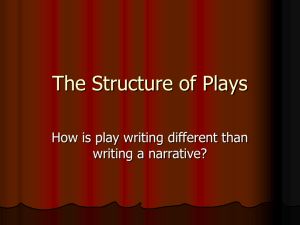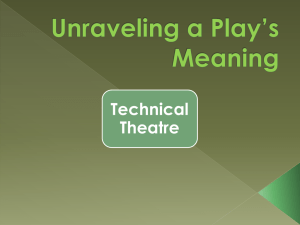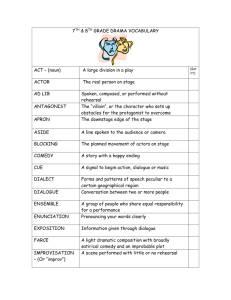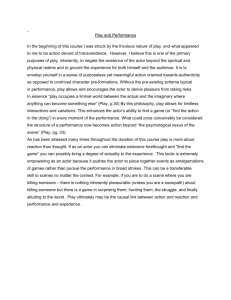What does language do? “Harry walked the cafe.”
advertisement
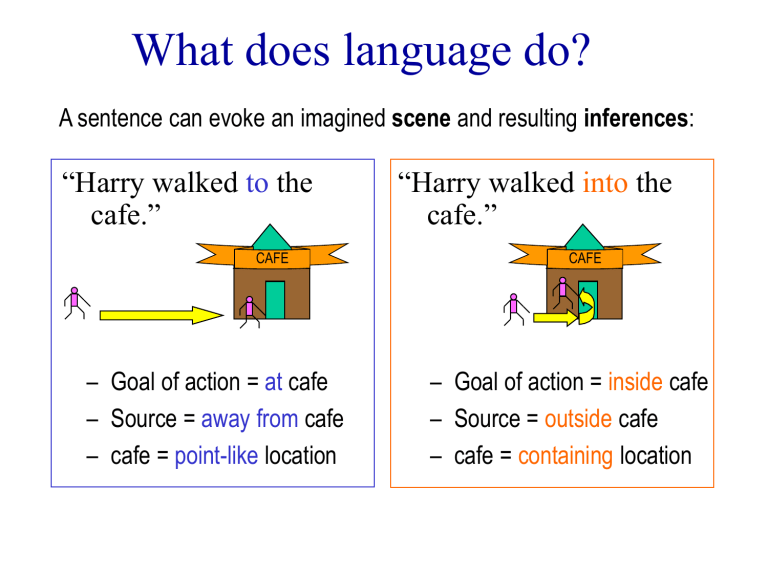
What does language do?
A sentence can evoke an imagined scene and resulting inferences:
“Harry walked to the
cafe.”
CAFE
– Goal of action = at cafe
– Source = away from cafe
– cafe = point-like location
“Harry walked into the
cafe.”
CAFE
– Goal of action = inside cafe
– Source = outside cafe
– cafe = containing location
Language understanding
(Utterance, Situation)
Conceptual
knowledge
Linguistic
knowledge
Analysis
Interpretation
Language understanding: analysis &
simulation
“Harry walked to the cafe.”
Utterance
Lexicon
Constructicon
General
Knowledge
Belief State
Analysis Process
Schema
walk
Trajector
Harry
Cafe
Goal
cafe
Semantic
Specification
Simulation
Interpretation: x-schema
simulation
walker at goal
Constructions can
• specify which
schemas and
entities are
involved in an
event, and how
they are related
• profile particular
stages of an event
• set parameters of
an event
energy
goal=home
walker=Harry
Harry is walking
home.
Traditional Levels of Analysis
Pragmatics
Semantics
Syntax
Morphology
Phonetics
“Harry walked into the cafe.”
Pragmatics
Semantics
Utterance
Syntax
Morphology
Phonetics
Construction Grammar
A construction is a form-meaning pair whose properties may not be
strictly predictable from other constructions.
(Construction Grammar, Goldberg 1995)
Form
Meaning
block
walk
to
Source
Trajector
Path
Goal
Form-meaning mappings for language
Linguistic knowledge consists of form-meaning mappings:
Meaning
Form
phonological
cues
word order
intonation
inflection
event structure
sensorimotor control
attention/perspective
social goals...
Cafe
Constructions as maps between
relations
Complex constructions are mappings between relations in form
and relations in meaning.
Form
Mover + Motion
before(Mover, Motion)
“is” + Action + “ing”
before(“is”, Action)
suffix(Action, “ing”)
Mover + Motion + Direction
before(Motion, Direction)
before(Mover, Motion)
Meaning
MotionEvent
mover(Motion, Mover)
ProgressiveAction
aspect(Action, ongoing)
DirectedMotionEvent
direction(Motion, Direction)
mover(Motion, Mover)
Embodied Construction Grammar
• Embodied representations
– active perceptual and motor schemas
– situational and discourse context
• Construction Grammar
– Linguistic units relate form and meaning/function.
– Both constituency and (lexical) dependencies allowed.
• Constraint-based (Unification)
– based on feature structures (as in HPSG)
– Diverse factors can flexibly interact.
Representing image schemas
schema name
schema Source-Path-Goal
roles
source
path
goal
trajector
role name
schema Container
roles
interior
exterior
portal
boundary
Boundary
Source
Trajector
Interior
Portal
Goal
Path
Exterior
These are abstractions over sensorimotor experiences.
Inference and Conceptual Schemas
• Hypothesis:
– Linguistic input is converted into a mental simulation based on bodilygrounded structures.
• Components:
– Semantic schemas
• image schemas and executing schemas are abstractions over neurally
grounded perceptual and motor representations
– Linguistic units
• lexical and phrasal construction representations invoke schemas, in part
through metaphor
• Inference links these structures and provides parameters for a
simulation engine
Embodied Construction Grammar
ECG
(Formalizing Cognitive Linguisitcs)
1. Linguistic Analysis
2. Computational Implementation
a. Test Grammars
b. Applied Projects – Question Answering
3. Map to Connectionist Models, Brain
4. Models of Grammar Acquisition
ECG Structures
• Schemas
– image schemas, force-dynamic schemas, executing
schemas, frames…
• Constructions
– lexical, grammatical, morphological, gestural…
• Maps
– metaphor, metonymy, mental space maps…
• Spaces
– discourse, hypothetical, counterfactual…
ECG Schemas
schema <name> subcase of
<schema> evokes
<schema> as
<local name>
roles < local role >:
<role restriction>
constraints
<role> ↔ <role>
<role> <value>
<predicate>
schema Hypotenuse subcase
of Line-Segment
evokes Right-Tri as rt
roles
{lower-left: Point}
{upper-right: Point}
constraints
self ↔ rt.long-side
Source-Path-Goal; Container
schema SPG
subcase of TrajLandmark
roles
source: Place
path: Directed–Curve
goal: Place
{trajector: Entity}
{landmark: BoundedRegion}
schema Container
roles
interior: Bounded-Region
boundary: Curve portal:
Bounded-Region
Referent Descriptor Schemas
schema RD
roles
category
gender
count
specificty
resolved Ref
modifications
schema RD5 // Eve
roles
HumanSchema
Female
one
Known
Eve Sweetser
none
ECG Constructions
construction <name>
subcase of <construction>
constituents
<name>:<construction>
form
constraints
<name> before/meets
<name>
meaning:
constraints
// same as for schemas
construction SpatialPP
constituents
prep: SpatialPreposition
lm: NP
form
constraints
prep meets lm
meaning:
TrajectorLandmark
constraints
selfm ↔ prep
landmark ↔ lm.category
Into and The CXNs
construction Into subcase
of SpatialPreposition
form: WordForm
constraints
orth "into"
meaning: SPG
evokes Container as c
constraints
landmark ↔ c
goal ↔ c.interior
construction The subcase
of Determiner
form:WordForm
constraints
orth "the"
meaning
evokes RD as rd
constraints
rd.specificity “known”
Two Grammatical CXNs
construction DetNoun
subcase of NP
constituents
d:Determiner
n:Noun
form constraints
d before n
meaning constraints
selfm ↔ d.rd
category ↔ n
construction NPVP subcase
of S constituents
subj: NP
vp: VP
form constraints
subj before vp
meaning constraints
profiled-participant ↔
subj
construction
ActiveSelfMotionPath
subcase of ActiveMotionPath Construction WalkedVerb
constituents
subcase of
{v: verb}
PastPerfectiveVerb form
constraints orth
{pp:SpatialPP}
"walked"
form constraints
meaning:WalkAction
{v before pp}
meaning:SelfMotionPathEvent
constraints
{spg ↔ pp}
{profiled-participant ↔ mover}
{profiled-process ↔ motion}
{profiled-process ↔ v}
Combined score determines best-fit
• Syntactic Fit:
– Constituency relations
– Combine with preferences on non-local elements
– Conditioned on syntactic context
• Antecedent Fit:
– Ability to find referents in the context
– Conditioned on syntax match, feature agreement
• Semantic Fit:
– Semantic bindings for frame roles
– Frame roles’ fillers are scored
0Eve1walked2into3the4house5
Constructs
Schema Instances
-------------------------------NPVP[0] (0,5)
SelfMotionPathEvent
Eve[3] (0,1)
[1]
ActiveSelfMotionPath
HouseSchema[66]
[2] (1,5)
WalkAction[60]
WalkedVerb[57] (1,2)
Person[4]
SpatialPP[56] (2,5)
SPG[58]
Into[174] (2,3)
RD[177] ~ house
DetNoun[173] (3,5)
RD[5]~ Eve
The[204] (3,4)
House[205] (4,5)
Unification chains and their fillers
SelfMotionPathEvent[1].mover
SPG[58].trajector
WalkAction[60].walker
RD[5].resolved-ref
RD[5].category
Filler: Person4
SelfMotionPathEvent[1]
.landmark
House[205].m
RD[177].category
SPG[58].landmark
Filler:HouseSchema66
SpatialPP[56].m
Into[174].m
SelfMotionPathEvent[1].spg
Filler: SPG58
WalkedVerb[57].m
WalkAction[60].routine
WalkAction[60].gait
SelfMotionPathEvent[1]
.motion
Filler:WalkAction60
Summary: ECG
• Linguistic constructions are tied to a model of
simulated action and perception
• Embedded in a theory of language processing
– Constrains theory to be usable
– Frees structures to be just structures, used in processing
• Precise, computationally usable formalism
– Practical computational applications, like MT and NLU
– Testing of functionality, e.g. language learning
• A shared theory and formalism for different
cognitive mechanisms
– Constructions, metaphor, mental spaces, etc.
Embodied Compositional
Semantics
after
Ellen Dodge
edodge@berkeley.edu
Questions
• What is the nature of compositionality in
the Neural Theory of Language?
• How can it be best represented using
Embodied Construction Grammar?
Examples
•
•
•
•
•
•
•
He bit the apple
He was bitten (by a toddler)
He bit into the apple
His white teeth bit into the apple.
He shattered the window
The window was shattered
The window shattered
Compositionality
• Put the parts together to create the meaning of
the whole.
• Questions:
– what is the nature of the parts?
– How and why do they combine with one another?
– What meaning is associated with this composition?
Short answers
• Parts = constructions, schemas
• Combination = binding, unification
• Meaning of the whole = simulation of
unified parts
Simulation parameters
• Constructions unify to create semantic
specification that supports a simulation
• Two types of simulation parameters for
event descriptions:
– Event content
– Event construal
Summary
• Parts = constructions, schemas
• Combination = binding, unification
• Meaning of the whole = simulation of the
combined parts
First example
• He bit the apple.
Schemas
schema MotorControl
subcase of Process
roles
Actor ↔ Protagonist
Effector
Effort
Routine
constraints
Actor ← animate
schema Contact
subcase of SpatialRelation
roles
Entity1: entity
Entity2: entity
schema ForceTransfer
evokes Conact as C
roles
Supplier ↔ C.entity1
Recipient ↔ C.entity2
Force
schema MotorControl
subcase of Process
roles
Actor ↔ Protagonist
Effector
Effort
Routine
constraints
Actor ← animate
schema ForceApplication
subcase of MotorControl
evokes ForceTransfer as FT
roles
Actor ↔ FT.Supplier ↔ Protagonist
Acted Upon↔ FT.Recipient
Effector
Routine
Effort ↔ FT.Force.amount
Schema networks
Contact
MotorControl
ForceTransfer
Motion
ForceApplication
CauseEffect
Effector
Motion
SelfMotion
MotionPath
Effector
MotionPath
Agentive Impact
SPG
SpatiallyDirectedAction
SelfMotion
Path
Contact
Verb Constructions
Construction BITE1
subcase of Verb
form: bite
meaning: ForceApplication
constraints:
Effector ← teeth
Routine ← bite // close mouth
schema ForceApplication
subcase of MotorControl
evokes ForceTransfer as FT
roles
Actor ↔ FT.Supplier ↔ Protagonist
Acted Upon ↔ FT.Recipient
Effector
Routine
Effort ↔ FT.Force.amount
Verb Constructions
cxn BITE
meaning: ForceApplication
cxn GRASP
meaning: ForceApplication
cxn PUSH
meaning: ForceApplication
cxn SLAP
meaning: AgentiveImpact
cxn KICK
meaning: AgentiveImpact
cxn HIT
meaning: AgentiveImpact
schema MotorControl
schema ForceApplication
subcase of MotorControl
schema Agentive Impact
subcase of ForceApplication
Argument Structure Construction
construction ActiveTransitiveAction2
subcase of VP
constituents:
V : verb
NP: NP
form
constraints:
VF before NPF
meaning: CauseEffect
evokes; EventDescriptor as ED; ForceApplication as FA
constraints:
{Selfm ↔ ED.EventType}
{Vm ↔ ED.ProfiledProcess}
Causer ↔ ED.ProfiledParticipant
FA ↔ Vm
Causer ↔ FA.Actor
Affected ↔ FA.ActedUpon
Affected ↔ NPm
Argument Structure Construction
construction ActiveTransitiveAction2
subcase of VP
constituents:
V : verb
NP: NP
form
constraints:
VF before NPF
meaning: CauseEffect
evokes; EventDescriptor as ED; ForceApplication as FA
constraints:
{Selfm ↔ ED.EventType}
{Vm ↔ ED.ProfiledProcess}
Causer ↔ ED.ProfiledParticipant
FA ↔ Vm
Causer ↔ FA.Actor
Affected ↔ FA.ActedUpon
Affected ↔ NPm
CauseEffect schema
schema CauseEffect
subcase of ForceApplication; Process
roles
Causer ↔ Actor
Affected ↔ ActedUpon ↔ Process.Protagonist
Instrument ↔ Effector
Schema Network
Contact
MotorControl
Process
ForceTransfer
Motion
ForceApplication
CauseEffect
Effector
Motion
SelfMotion
MotionPath
Effector
MotionPath
Agentive Impact
SPG
SpatiallyDirectedAction
SelfMotion
Path
Contact
Argument Structure Construction
construction ActiveTransitiveAction2
subcase of VP
constituents:
V : verb
NP: NP
form
constraints:
VF before NPF
meaning: CauseEffect
evokes: EventDescriptor as ED; ForceApplication as FA
constraints:
{Selfm ↔ ED.EventType}
{Vm ↔ ED.ProfiledProcess}
Causer ↔ ED.ProfiledParticipant
FA ↔ Vm
Causer ↔ FA.Actor
Affected ↔ FA.ActedUpon
Affected ↔ NPm
Schema Network
Contact
MotorControl
Process
ForceTransfer
Motion
ForceApplication
CauseEffect
Effector
Motion
SelfMotion
MotionPath
Effector
MotionPath
Agentive Impact
SPG
SpatiallyDirectedAction
SelfMotion
Path
Contact
Important points
Compositionality does not require that each
component contain different information.
Shared semantic structure is not viewed as
an undesirable redundancy
Argument Structure Construction
construction ActiveTransitiveAction2
subcase of VP
constituents:
V : verb
NP: NP
form
constraints:
VF before NPF
meaning: CauseEffect
evokes; EventDescriptor as ED; ForceApplication as FA
constraints:
{Selfm ↔ ED.EventType}
{Vm ↔ ED.ProfiledProcess}
Causer ↔ ED.ProfiledParticipant
FA ↔ Vm
Causer ↔ FA.Actor
Affected ↔ FA.ActedUpon
Affected ↔ NPm
Event Descriptor schema
schema EventDescriptor
roles
EventType: Process
ProfiledProcess: Process
ProfiledParticipant: Entity
ProfiledState(s): State
SpatialSetting
TemporalSetting
Argument Structure Construction
Construction ActiveTransitiveAction2
subcase of VP
constituents:
V : verb
NP: NP
form
constraints:
VF before NPF
meaning: CauseEffect
evokes; EventDescriptor as ED; ForceApplication as FA
constraints:
{Selfm ↔ ED.EventType}
{Vm ↔ ED.ProfiledProcess}
Causer ↔ ED.ProfiledParticipant
FA ↔ Vm
Causer ↔ FA.Actor
Affected ↔ FA.ActedUpon
Affected ↔ NPm
Bindings with other cxns
construction NPVP1
constituents:
Subj: NP
VP : VP
form
Constraints
Subj f before VPf
meaning: EventDescriptor
ProfiledParticipant ↔ Subjm
construction ActiveTransitiveAction2
subcase of VP
constituents: V ; NP
form: VF before NPF
meaning: CauseEffect
evokes; EventDescriptor as ED
constraints:
{Selfm ↔ ED.EventType}
{Vm ↔ ED.ProfiledProcess}
Causer ↔ ED.ProfiledParticipant
Affected ↔ NPm
Bindings with other cxns
Construction NPVP1
constituents:
Subj: NP
VP : VP
form
constraints
Subj f before VPf
meaning: EventDescriptor
ProfiledParticipant ↔ Subjm
schema EventDescriptor
roles
EventType
ProfiledProcess
ProfiledParticipant
ProfiledState(s)
SpatialSetting
TemporalSetting
construction ActiveTransitiveAction2
subcase of VP
constituents: V ; NP
form: VF before NPF
meaning: CauseEffect
evokes; EventDescriptor as ED
constraints:
{Selfm ↔ ED.EventType}
{Vm ↔ ED.ProfiledProcess}
Causer ↔ ED.ProfiledParticipant
Affected ↔ NPm
Bindings with other cxns
construction NPVP1
constituents:
Subj: NP
VP : VP
form
Constraints
Subj f before VPf
meaning: EventDescriptor
ProfiledParticipant ↔ Subjm
schema EventDescriptor
roles
EventType
ProfiledProcess
ProfiledParticipant
ProfiledState(s)
SpatialSetting
TemporalSetting
construction ActiveTransitiveAction2
subcase of VP
constituents: V ; NP
form: VF before NPF
meaning: CauseEffect
evokes; EventDescriptor as ED
constraints:
{Selfm ↔ ED.EventType}
{Vm ↔ ED.ProfiledProcess}
Causer ↔ ED.ProfiledParticipant
Affected ↔ NPm
Unification
Meaning
EventDescriptor
EventType
ProfiledProcess
ProfiledParticipant
Constructions
NPVP1
CauseEffect
causer
affected
TransitiveAction2
ForceApplication
actor
actedupon
BITE
NP2
ReferentDescriptor
THE
ReferentDescriptor
NP1
HE
APPLE
Unification
Meaning
EventDescriptor
EventType
ProfiledProcess
ProfiledParticipant
Constructions
NPVP1
CauseEffect
causer
affected
TransitiveAction2
ForceApplication
actor
actedupon
BITE
NP2
ReferentDescriptor
THE
ReferentDescriptor
resolved referent
NP1
HE
APPLE
Unification
Meaning
EventDescriptor
eventtype
ProfiledProcess
ProfiledParticipant
Constructions
NPVP1
CauseEffect
causer
affected
TransitiveAction2
Verb
ForceApplication
actor
actedupon
BITE
NP2
ReferentDescriptor
THE
ReferentDescriptor
resolved referent
NP1
HE
APPLE
Unification
Meaning
EventDescriptor
eventtype
ProfiledProcess
ProfiledParticipant
Constructions
NPVP1
subj
CauseEffect
causer
affected
TransitiveAction2
ForceApplication
actor
actedupon
BITE
NP2
ReferentDescriptor
THE
ReferentDescriptor
NP1
HE
APPLE
Unification
Meaning
EventDescriptor
eventtype
ProfiledProcess
ProfiledParticipant
Constructions
NPVP1
CauseEffect
causer
affected
TransitiveAction2
NP
ForceApplication
actor
actedupon
BITE
NP2
ReferentDescriptor
THE
ReferentDescriptor
NP1
HE
APPLE
Semantic Specification
He bit the apple
EventDescriptor
eventtype
ProfiledProcess
ProfiledParticipant
RD27
category
CauseEffect
causer
affected
ForceApplication
actor
actedupon
routine bite
effector teeth
Person
Apple
RD55
category
Simulation He bit the apple
CauseEffect
ForceApplication
Protagonist =
Affected ↔
ActedUpon
Process
Protagonist =
Causer ↔ Actor
Simulation He bit the apple
CauseEffect
ForceApplication
Protagonist =
Affected ↔
ActedUpon
Process
Protagonist =
Causer ↔ Actor
Passive voice
He was bitten (by a toddler)
Argument Structure Construction
He was bitten (by a toddler)
construction PassiveTransitiveAction2
subcase of VP
constituents:
V : PassiveVerb
(PP: agentivePP)
form
constraints:
VF before PPF
meaning: CauseEffectAction
evokes; EventDescriptor as ED; ForceApplication as FA
constraints:
{Selfm ↔ ED.EventType}
{Vm ↔ ED.ProfiledProcess}
Affected ↔ ED.ProfiledParticipant
FA ↔ Vm
Causer ↔ FA.Actor
Affected ↔ FA.ActedUpon
Causer ↔ PP.NPm
Semantic Specification
He was bitten (by a toddler)
EventDescriptor
eventtype
ProfiledProcess
ProfiledParticipant
RD27
category
CauseEffect
causer
affected
ForceApplication
actor
actedupon
routine bite
effector teeth
Person
Person
RD48
category
Simulation He was bitten (by a toddler)
CauseEffect
Action = Bite
Protagonist
= Affected ↔
ActedUpon
Effect = Process
Protagonist =
Causer ↔ Actor
Variations on a theme
• He shattered the window
• The window was shattered
• The window shattered
Verb Construction -- shatter
Construction SHATTER1
subcase of Verb
form: shatter
meaning: StateChange
constraints:
Initial :: Undergoer.state ← whole
Final :: Undergoer.state ← shards
schema StateChange
subcase of Process
roles
Undergoer ↔ Protagonist
Argument Structure Construction
He shattered the window
construction ActiveTransitiveAction3
subcase of VP
constituents:
V : verb
NP: NP
form
constraints:
VF before NPF
meaning: CauseEffect
evokes: EventDescriptor as ED; StateChange as SC
constraints:
{Selfm ↔ ED.EventType}
{Vm ↔ ED.ProfiledProcess}
Causer ↔ ED.ProfiledParticipant
SC ↔ Vm
Affected ↔ SC.Undergoer
Affected ↔ NPm
Semantic Specification
He shattered the window
EventDescriptor
eventtype
ProfiledProcess
ProfiledParticipant
RD27
category
CauseEffect
causer
affected
StateChange
Undergoer
state “wholeness”
Person
Window
RD189
category
Simulation He shattered the window
CauseEffect
Action
Protagonist =
Affected ↔
Undergoer
Protagonist =
Causer
Process
Argument Structure Construction
The window was shattered
construction PassiveTransitiveAction3
subcase of VP
constituents:
V : PassiveVerb
(PP: agentivePP)
form
constraints:
VF before NPF
meaning: CauseEffect
evokes: EventDescriptor as ED; StateChange as SC
constraints:
{Selfm ↔ ED.EventType}
{Vm ↔ ED.ProfiledProcess}
Affected ↔ ED.ProfiledParticipant
SC ↔ Vm
Affected ↔ SC.Undergoer
Causer ↔ PP.NPm
Semantic Specification
The window was shattered
EventDescriptor
eventtype
ProfiledProcess
ProfiledParticipant
CauseEffect
causer
affected
Window
StateChange
Undergoer
state “wholeness”
RD175
category
Simulation The window was shattered
CauseEffect
Action
Protagonist =
Affected ↔
Undergoer
Protagonist =
Causer
Process
Argument Structure Construction
The window shattered
construction ActiveIntransitiveAction1
subcase of VP
constituents:
V : verb
form
meaning: Process
evokes: EventDescriptor as ED; StateChange as SC
constraints:
{Selfm ↔ ED.EventType}
{Vm ↔ ED.ProfiledProcess}
Protagonist ↔ ED.ProfiledParticipant
SC ↔ Vm
Protagonist ↔ SC.Undergoer
Semantic Specification
The window shattered
EventDescriptor
eventtype
ProfiledProcess
ProfiledParticipant
Process
protagonist
Window
StateChange
Undergoer
state “wholeness”
RD177
category
Simulation The window shattered
Process
Protagonist =
Undergoer
Process
Some more variations on a theme
• He bit the apple
• He bit into the apple
• His white teeth bit into the apple.
Argument Structure Construction
He bit into the apple
construction ActiveEffectorMotionPath2
subcase of VP
constituents:
V : verb
PP: Spatial-PP
form
constraints:
VF before PPF
meaning: EffectorMotionPath
evokes; EventDescriptor as ED; ForceApplication as FA
constraints:
{Selfm ↔ ED.EventType}
{Vm ↔ ED.ProfiledProcess}
Actor ↔ ED.ProfiledParticipant
FA ↔ Vm
Actor ↔ FA.Actor
Effector ↔ FA.Effector // INI
Target ↔ FA.ActedUpon
SPG ↔ PPm
Target ↔ PPm .Prep.LM
Schema
schema EffectorMotionPath
subcase of EffectorMotion
subcase of SPG // or evokes SPG
roles
Actor ↔ MotorControl.protagonist
Effector ↔ SPG.Tr ↔ M.Mover ↔ Motion.protagonist
Target ↔ SPG.Lm
Schema Network
Contact
MotorControl
Process
ForceTransfer
Motion
ForceApplication
CauseEffect
Effector
Motion
SelfMotion
MotionPath
Effector
MotionPath
Agentive Impact
SPG
SpatiallyDirectedAction
SelfMotion
Path
Contact
Argument Structure Construction
He bit into the apple
construction ActiveEffectorMotionPath2
subcase of VP
constituents:
V : verb
PP: Spatial-PP
form
constraints:
VF before PPF
meaning: EffectorMotionPath
evokes: EventDescriptor as ED; ForceApplication as FA
constraints:
{Selfm ↔ ED.EventType}
{Vm ↔ ED.ProfiledProcess}
Actor ↔ ED.ProfiledParticipant
FA ↔ Vm
Actor ↔ FA.Actor
Effector ↔ FA.Effector // INI
Target ↔ FA.ActedUpon
SPG ↔ PPm
Target ↔ PPm .Prep.LM
EffectorMotionPath
Action
Protagonist = Actor
Effector
Motion
Source
Protagonist = Effector
Path
Goal
Argument Structure Construction
He bit into the apple
construction ActiveEffectorMotionPath2
subcase of VP
constituents:
V : verb
PP: Spatial-PP
form
constraints:
VF before PPF
meaning: EffectorMotionPath
evokes; EventDescriptor as ED; ForceApplication as FA
constraints:
{Selfm ↔ ED.EventType}
{Vm ↔ ED.ProfiledProcess}
Actor ↔ ED.ProfiledParticipant
FA ↔ Vm
Actor ↔ FA.Actor
Effector ↔ FA.Effector // INI
Target ↔ FA.ActedUpon
SPG ↔ PPm
Target ↔ PPm .Prep.LM
Simulation: He bit into the apple
Action
Protagonist = Actor
Effector
Motion
Source
Protagonist = Effector
Path
Goal
Argument Structure Construction
His white teeth bit into the apple
construction ActiveEffectorMotionPath3
subcase of VP
constituents:
V : verb
PP: Spatial-PP
form
constraints:
VF before PPF
meaning: EffectorMotionPath
evokes; EventDescriptor as ED; ForceApplication as FA
constraints:
{Selfm ↔ ED.EventType}
{Vm ↔ ED.ProfiledProcess}
Effector ↔ ED.ProfiledParticipant
FA ↔ Vm
Actor ↔ FA.Actor // INI
Effector ↔ FA.Effector
Target ↔ FA.ActedUpon
SPG ↔ PPm
Target ↔ PPm .Prep.LM
Simulation: His white teeth bit into the apple
Action
Protagonist = Actor
Effector
Motion
Source
Protagonist = Effector
Path
Goal
Non-agentive biting
• He landed on his feet, hitting the narrow pavement
outside the yard with such jarring impact that his
teeth bit into the edge of his tongue. [BNC]
• The studs bit into Trent's hand. [BNC]
• His chest burned savagely as the ropes bit into his
skin. [BNC]
Schema Network
Contact
MotorControl
Process
ForceTransfer
Motion
ForceApplication
CauseEffect
Effector
Motion
SelfMotion
MotionPath
Effector
MotionPath
Agentive Impact
SPG
SpatiallyDirectedAction
SelfMotion
Path
Contact
Simulation: His teeth bit his tongue
Motion
Protagonist = Mover
Source
Path
Goal
Summary
• Small set of constructions and schemas
• Composed in different ways
• Unification produces specification of
parameters of simulation
• Sentence understanding is simulation
• Different meanings = different simulations
Concluding Remarks
• Complexity
• Simulation
Concluding Remarks
•
•
•
•
Complexity
Simulation
Language understanding is simulation
Simulation involves activation of
conceptual structures
• Simulation specifications should include:
– which conceptual structures to activate
– how these structures should be activated
Extra slides follow:
Prototypes and extensions?
CauseMotion Path:
• He threw the ball across the room
• He kicked the ball over the table
• He sneezed the napkin off the table
• [He coughed the water out of his lungs]
Key points
• In prototypical verb-argument structure
construction combinations, verb meaning is very
similar to argument structure meaning.
• Verbs whose meaning partially overlaps that of a
given argument structure constructions may also
co-occur with that argument structure construction
• These less prototypical combinations may
motivate extensions to the central argument
structure constructions

